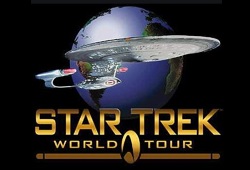
The history of the Star Trek universe stretches across time itself, from the first humanoid race who planted the seeds of life throughout the galaxy over four billion years ago, all the way to the year 2372 and the Klingon-Cardassian War. In between, Vulcans embraced the doctrine of logic, the Klingon Empire was born, and the human race successfully landed on the Moon, a predecessor to its eventual exploration of space as the Final Frontier.
On December 5, 1998, the Star Trek World Tour exhibit premiered in the German city of Düsseldorf before traveling to Vienna and then Singapore the following year. Although short lived, the exhibition was arguably the largest and most extensive of its kind, and while it may have been a homage to a fictional television and film franchise, it also served as a “museum from the future” that explored the history and evolution of life and the multitudes of civilizations that encompass the galaxy.
The first part of Star Trek World Tour contained replicas of the different sections that encompass the USS Enterprise. Visitors received a working knowledge of how various instruments operated, and were even able to watch as Starfleet personnel contained a warp core meltdown in Engineering. The Bridge, meanwhile, offered hands-on experience operating the helm and navigation consoles and featured an additional reenactment when the vessel was attacked by the Borg.
After having visited the Enterprise, attendees made their way through a make-shift “museum” filled with costumes and props used in the original Star Trek television series and spin-offs Next Generation, Deep Space 9 and Voyager, as well as initial batch of motion pictures. In keeping with the allusion of being an actual museum from the future and not just a testament to a fictional science fiction franchise, Star Trek World Tour featured Starfleet personnel interacting with visitors and discussing costume designs and the various props.
Communicators, phasers and medical equipment from the various Star Trek incarnations, meanwhile, were displayed side-by-side and highlighted the evolution of these fictional devices as if they were real. On the original Star Trek television show, for instance, communicators were hand-held and flipped open, while the first Star Trek motion picture depicted them as part of a wristband. By the times of Star Trek: The Next Generation, the insignia badges worn on Starfleet uniforms were themselves communicators that could be activated with a simple tap.
In many ways, the evolution of these fictional communicator reflects the evolution of real world cell phones, which first appeared as bulky mobile units before becoming flip-phones based on the design from Star Trek: The Original Series, with Bluetooth later eliminating the need to hold a physical phone to one’s ear and the wristband-like iWatch creating an even easier way to communicate.
Medical equipment likewise became more compact and powerful during the eighty years that separated the initial exploits of Captain James T. Kirk from those of his Next Generation counterpart Jean-Luc Picard. The tricorder is arguably the most memorable, and the bulky, rectangular device once carried by Doctor Leonard “Bones” McCoy via an attached shoulder strap eventually evolved into the smaller, hand-held device utilized by Doctor Beverly Crusher in the twenty-fourth century.
Like with the communicator, the tricorder offers a fictional account of real-world advances within the medical profession. Although announced ten years after the Star Trek World Tour concluded in Singapore, the San Diego-based Qualcomm established the Tricorder X Prize competition in 2012, offering $7 million dollars for the development of an “automatic non-invasive health diagnostics system in a single portable package able to autonomously diagnose thirteen medical conditions.”
While none of the initial 230 teams from thirty different countries were able to meet all of the criteria for a contemporary tricorder, efforts still continue to bring the fictional medical science of Star Trek to hospitals and medical professionals of the twenty-first century nonetheless.
After having explored the costumes and props from the various incarnations of Star Trek, visitors to Star Trek World Tour received an education on the “strange new worlds” that encompass the Star Trek universe with an exploration of the various alien races that reside there. Klingons, Vulcans and Ferengi were on-hand to answer questions, while an entire section of the traveling exhibit was dedicated to life-like busts of the many races that the various Enterprises encountered during their missions.
In the Star Trek: The Next Generation episode “The Chase,” archaeologists discovered that DNA fragments recovered from different worlds across the galaxy contained components that were compatible with one another. A search for similar DNA led to a holographic message from the past that explained how an ancient humanoid race planted the seeds of life on various planets over four billion years earlier.
Thus while Klingons, Vulcans, Cardassians, Ferengi and even the humans of planet Earth may have evolved differently, the revelation contained within “The Chase” suggests that each of these races were all related to each other nonetheless, making even a galaxy as large as the Milky Way a much smaller place in the process.
The knowledge that the aliens seen mingling with the human visitors of Star Trek World Tour may have more in common than originally believed also demonstrated that intergalactic peace – a central concept of the Star Trek universe – was a realistic possibility after all. The same holds true for the diverse races of planet Earth, who have even more in common than Klingons and Vulcans.
The Star Trek Word Tour may have been a short one – encompassing a mere two years and three cities – but its scope and ambition eclipsed other such endeavors both before and after. Although Star Trek may be fictional, its history often mirrors our own nonetheless, and an exploration of a “museum from the future” that tells the story of Star Trek can likewise offer a blueprint to our own future, a fact that Star Trek World Tour made abundantly clear.
Anthony Letizia

